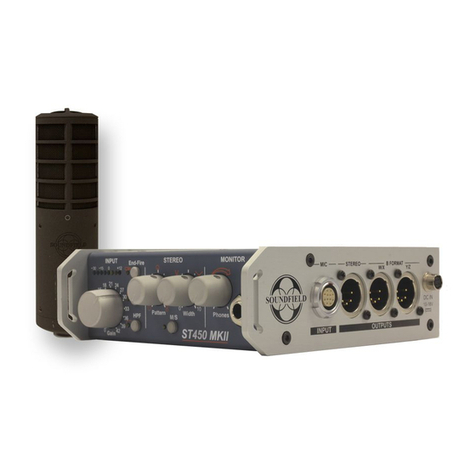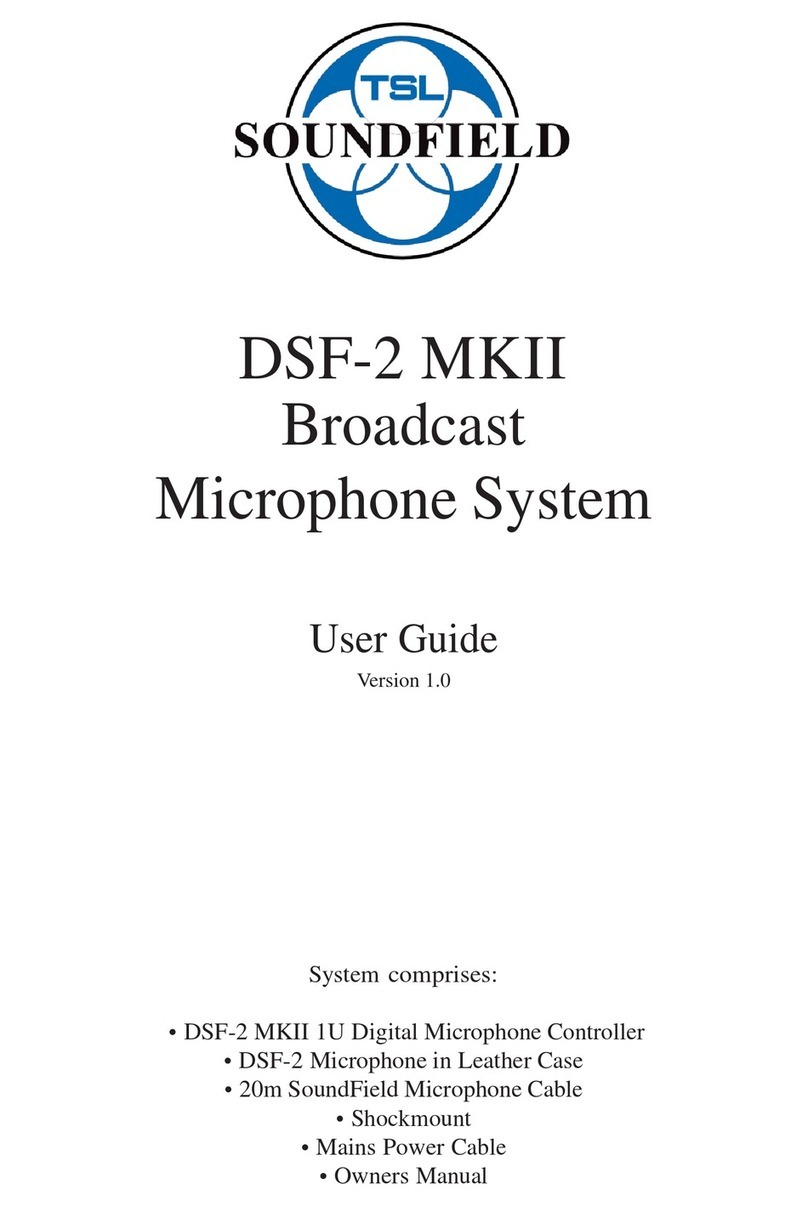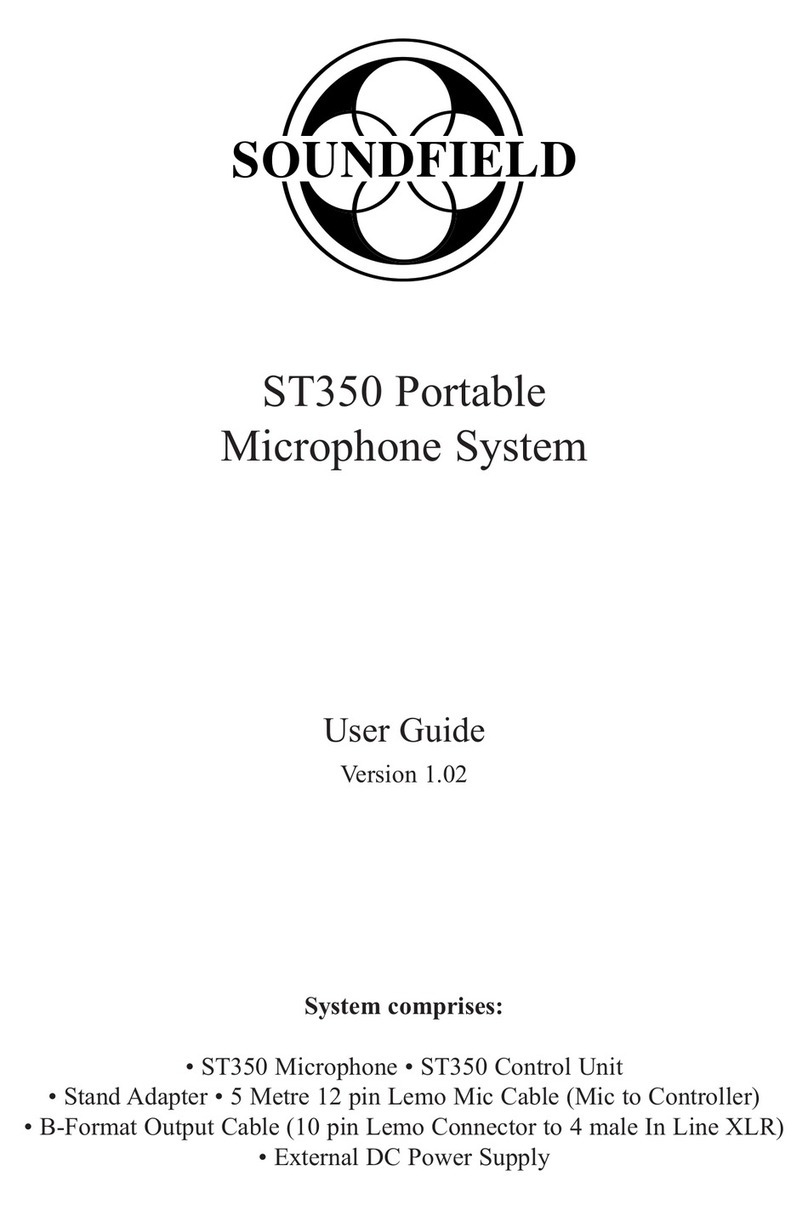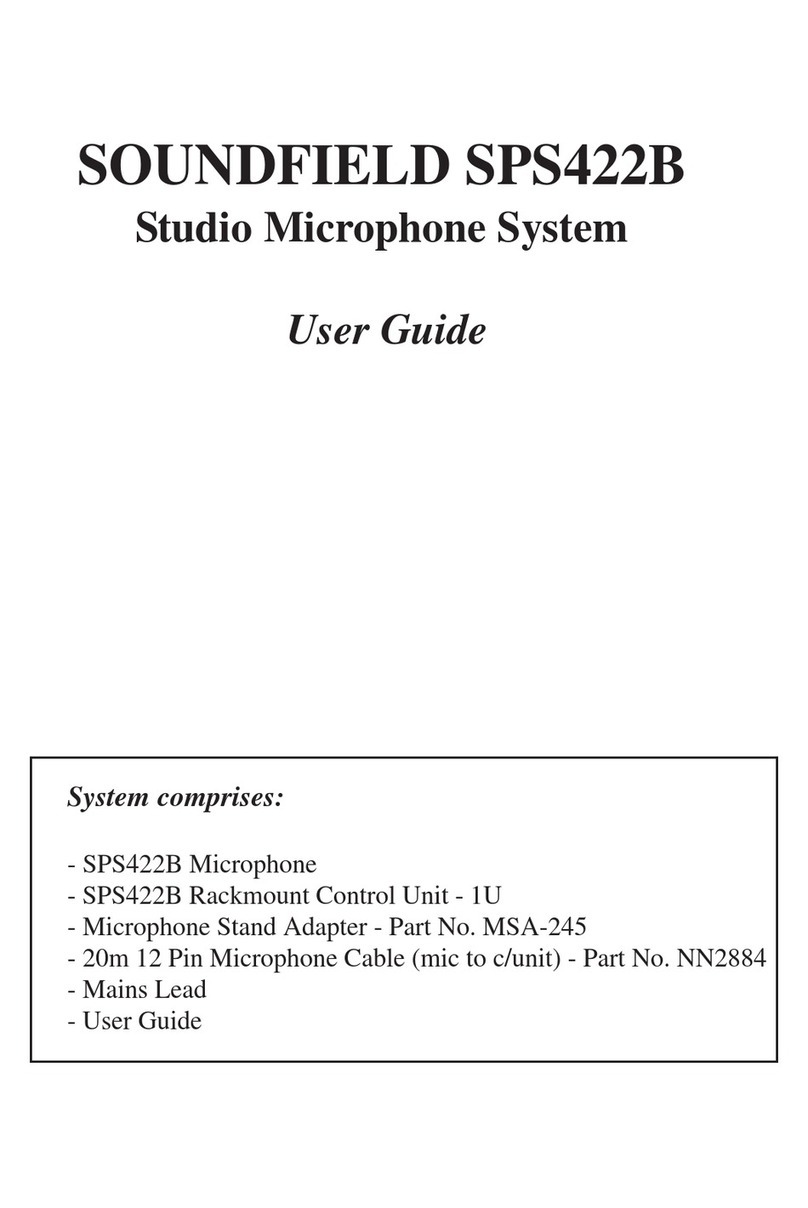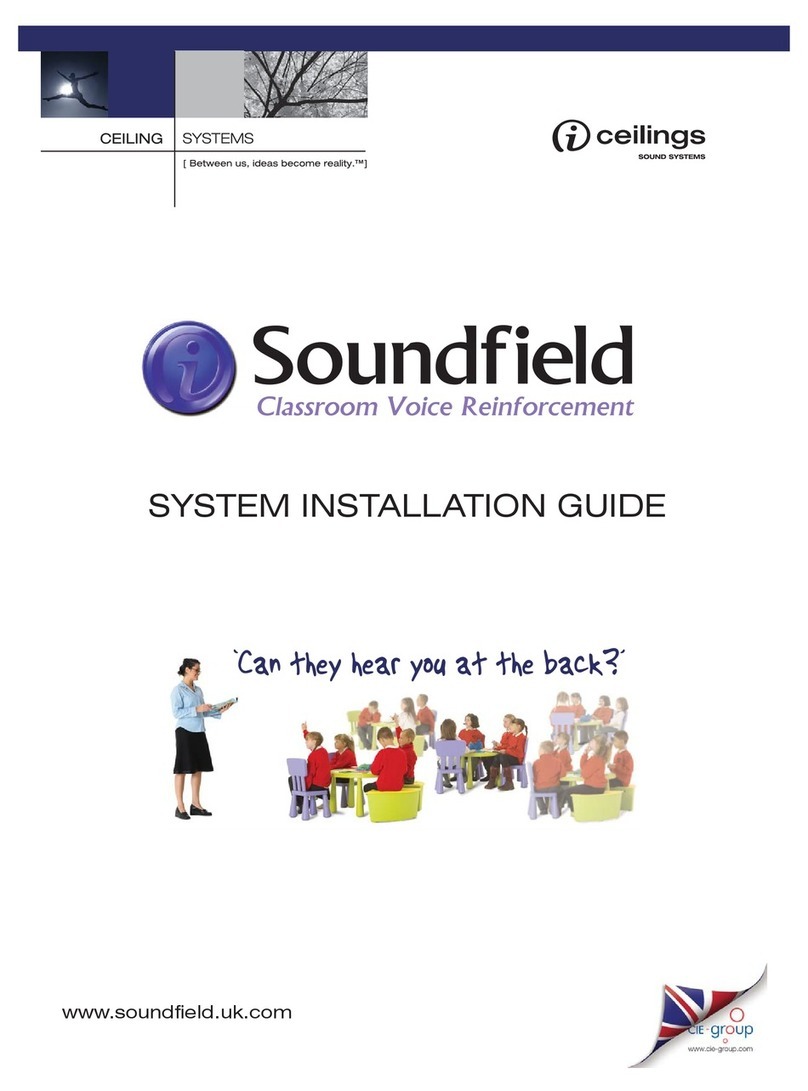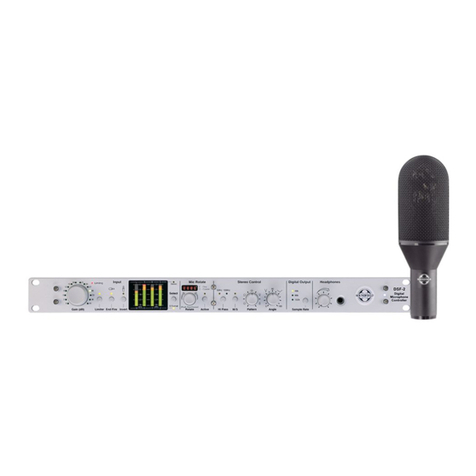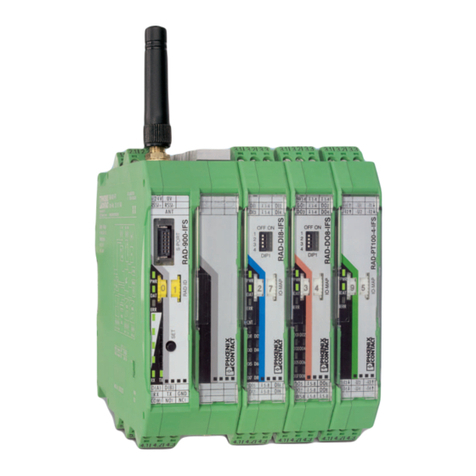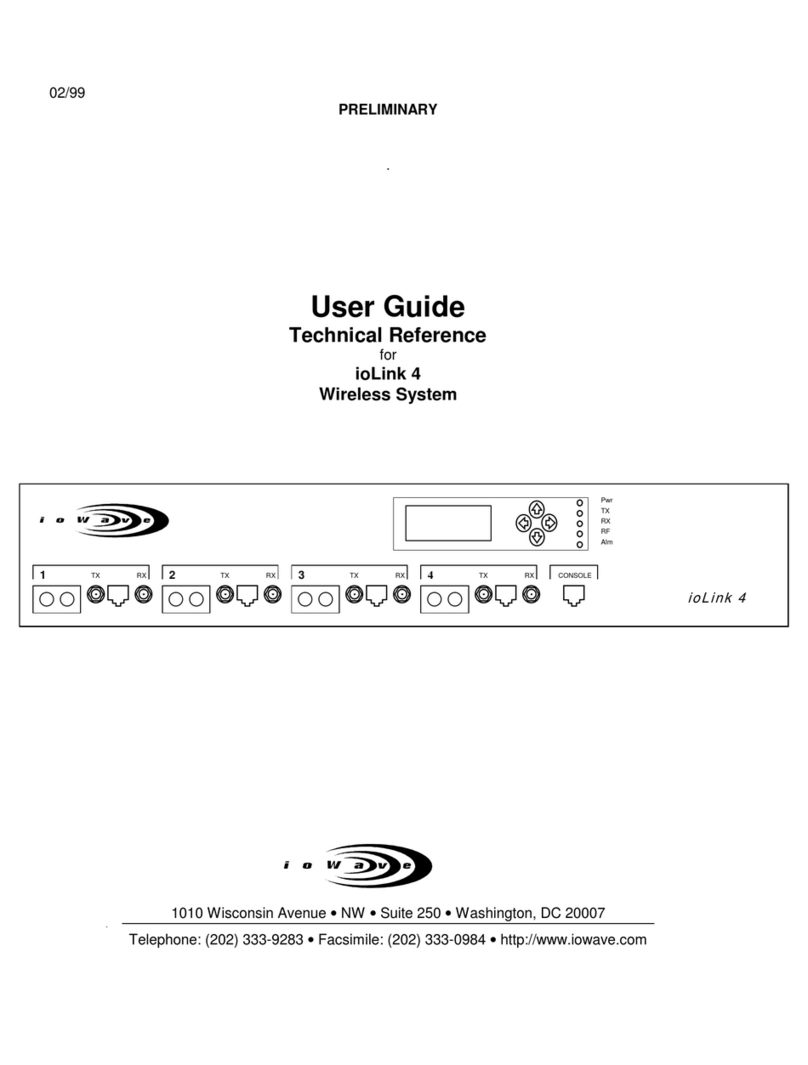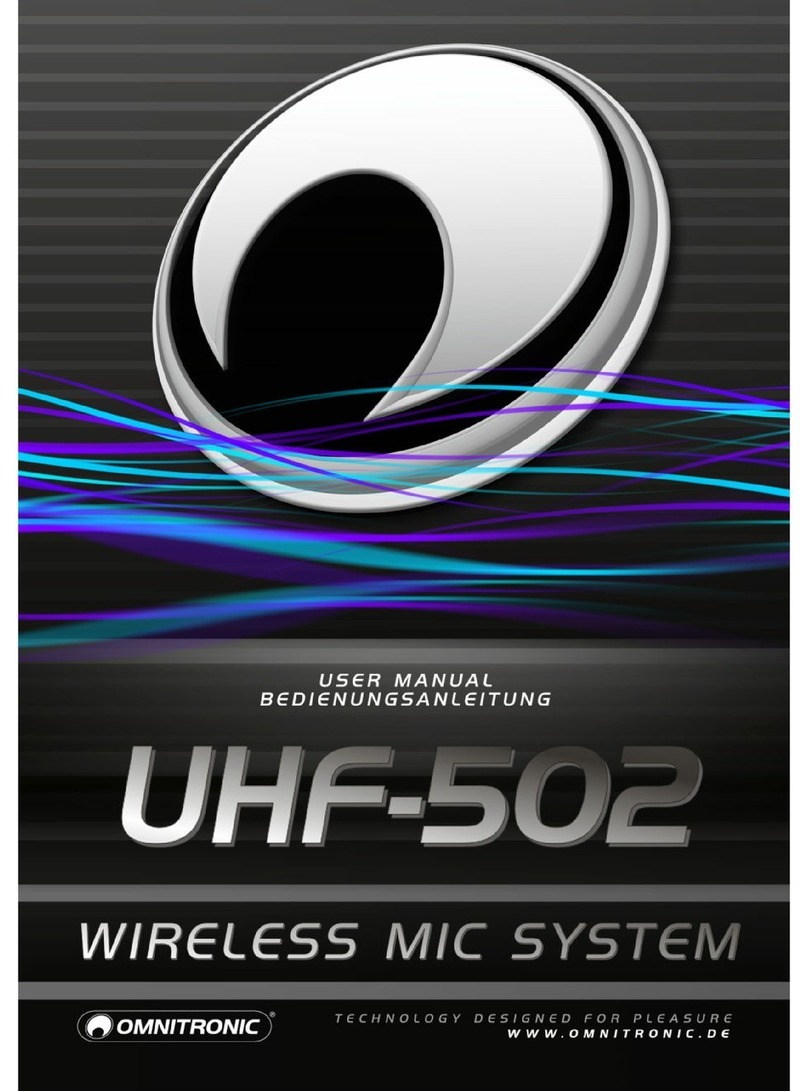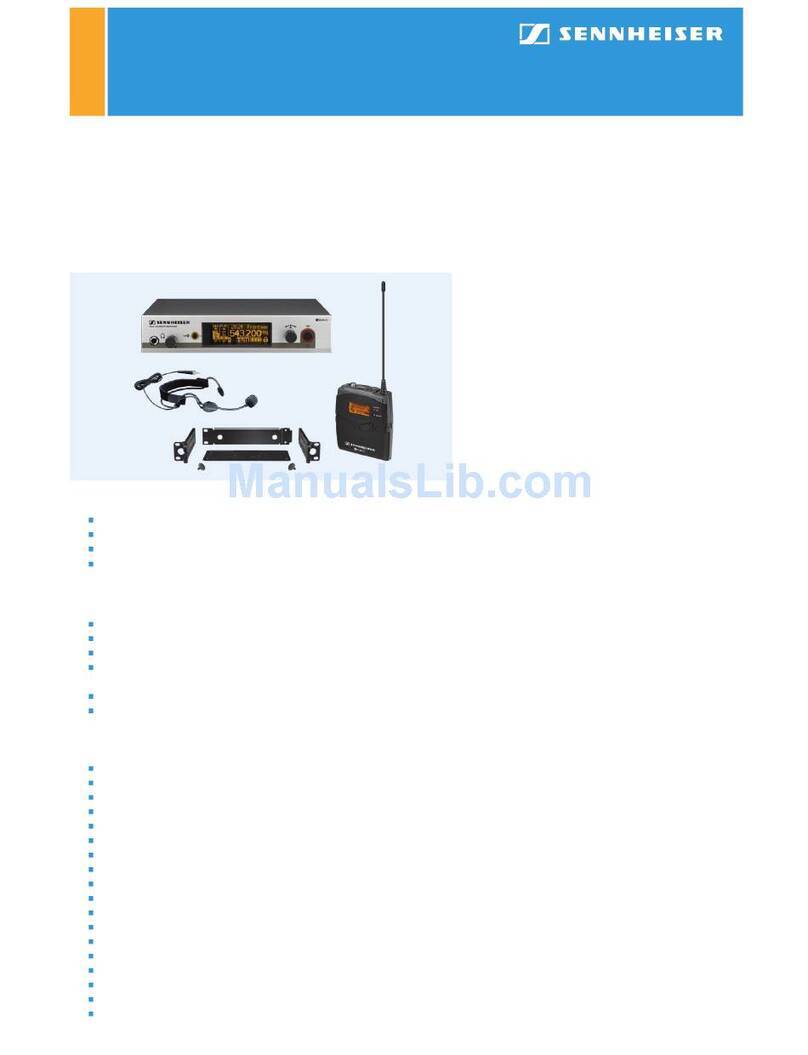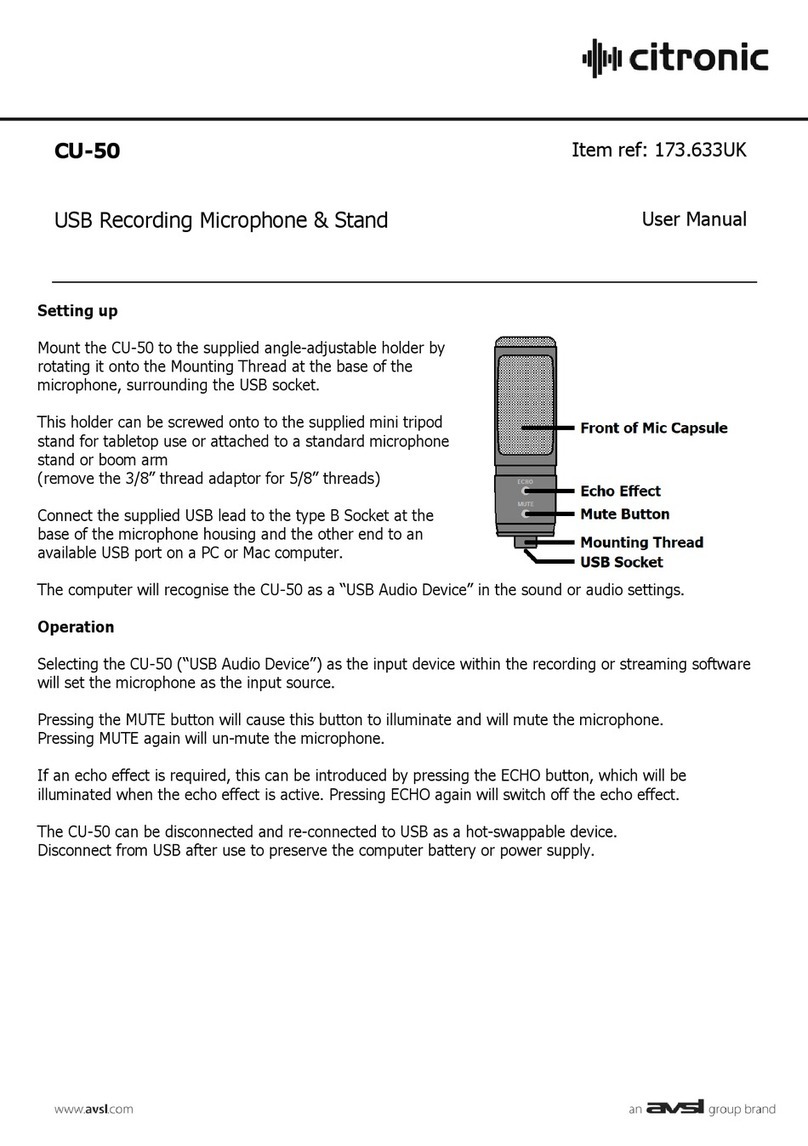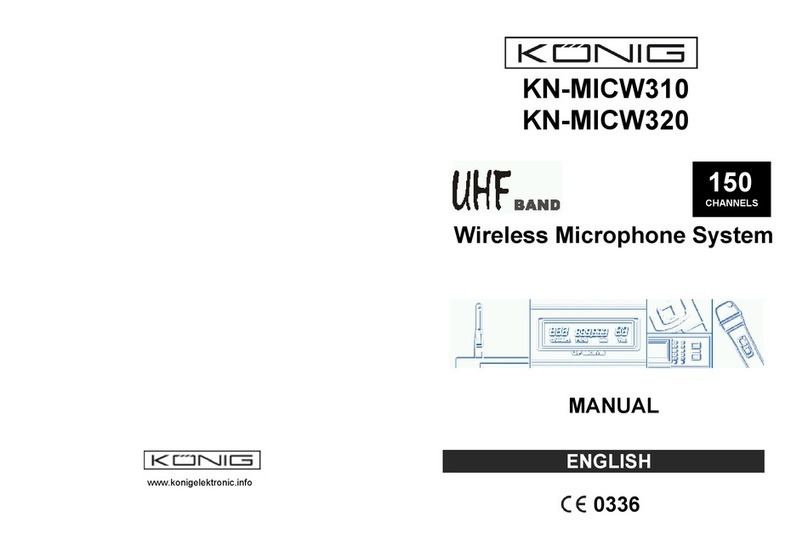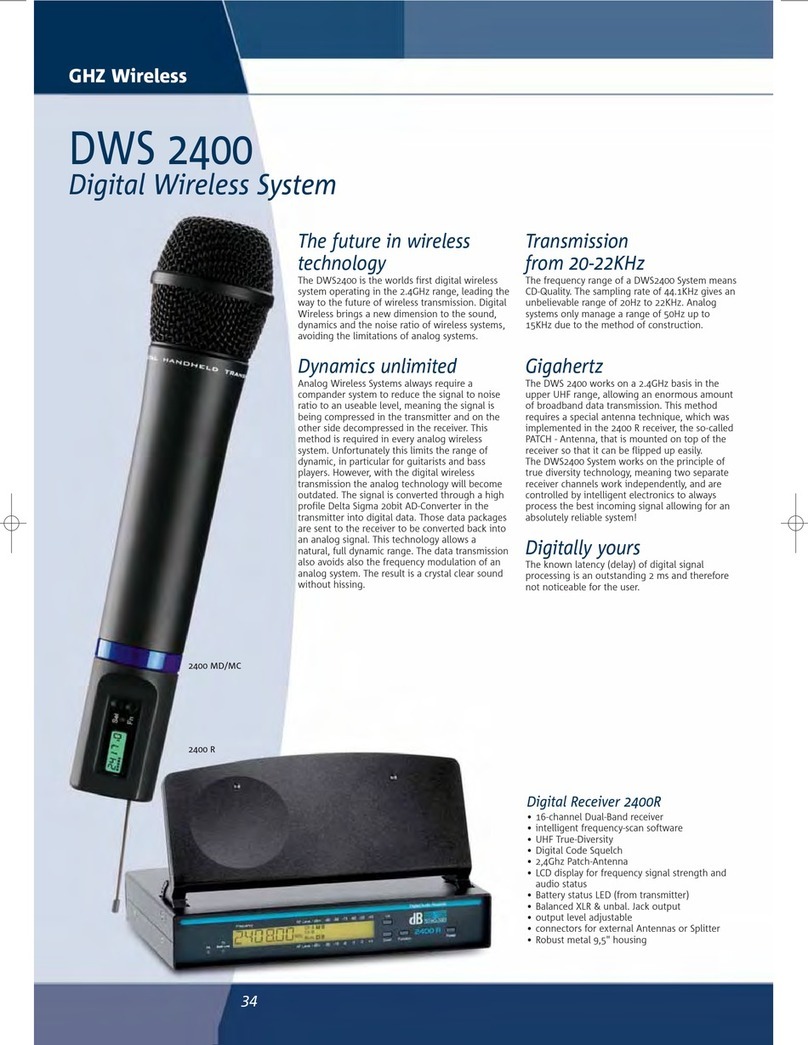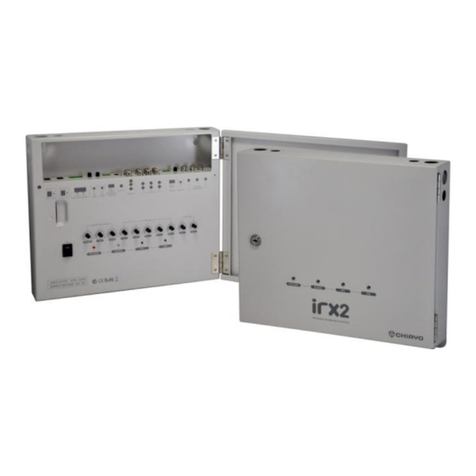Soundfield DSF-1 User manual

DSF-1 Performance
Microphone System
User Guide
Version 1.0
SOUNDFIELD
System comprises:
• DSF-1 1U Digital Microphone Controller
• DSF-1 Microphone in Leather Case
• 20m SoundField Microphone Cable
• Shockmount
• Mains Power Cable
• Owners Manual

SoundField DSF-1 User Guide
Page 2Table of Contents
TABLE OF CONTENTS
Safety Information - - - - - - - - - - 3
Introduction - - - - - - - - - - - 4
How Does it Work? - - - - - - - - - - 5-6
Getting Started - - - - - - - - - - 7-8
Controls-----------9-13
Post Production Surround Sound:
Using the DSF-1 with SoundField ‘Surround Zone’ Software - - - - 14
Specification - - - - - - - - - - - 15
Warranty-----------16
Shipping and Quality Assurance - - - - - - - 17
12 Pin Connector Wiring Details for SoundField Microphone Cables - - - 18

SoundField DSF-1 User Guide
Page 3Safety Information
SAFETY INFORMATION
• This equipment must be EARTHED.
• Only suitably trained personnel should service this equipment.
• Please read and take note of all warning and informative labels.
• Before starting any servicing operation, this equipment must be isolated from the AC supply (mains) by removing the
incoming IEC mains connector.
• Fuses should only be replaced with ones of the same type and rating as that indicated.
• Operate only in a clean, dry and pollutant-free environment.
• Do not operate in an explosive atmosphere.
• Do not allow any liquid or solid objects to enter the equipment. Should this accidentally occur then immediately
switch off the unit and contact your service agent.
• Do not allow ventilation slots to be blocked.
Cleaning
For cleaning the front panels of the equipment we recommend anti-static screen cleaner sprayed onto a soft cloth to
dampen it only.
Explanation of Warning Symbols
The lightening flash with arrow head symbol within an equilateral triangle is
intended to alert the user to the presence of dangerous voltages and energy levels
within the product’s enclosure that may be of sufficient magnitude to constitute a
risk of electric shock or injury.
The exclamation mark within an equilateral triangle is intended to prompt the user to
refer to important operating or maintenance (servicing) instructions in the
documentation supplied with the product.

SoundField DSF-1 User Guide
Page 4Introduction
INTRODUCTION
The DSF-1 Microphone System has been specifically designed to capture simultaneous high
quality surround and stereo in both live concerts and recording studio environments. Its advantage
over alternative methods is that the multi-channel audio it generates from a ‘single point’ source is
completely phase coherent - therefore making it possible to collapse the surround to stereo or
mono without loss of information, frequency imbalance or any of the other phase problems
associated with spaced microphones or multi capsule ‘dummy head’ arrangements.
All processing is in the digital domain and the 1U controller is equipped with 110Ω AES-EBU
outputs on XLR connectors. The DSF-1 outputs digital stereo Left/Right, stereo M/S and four
channels of digital SoundField B-Format called W, X, Y and Z which is the surround sound
information. A single lightweight multiway cable is used to connect the microphone to the DSF-1
controller which as well as carrying the individual capsule signals also supplies the necessary
power to the microphone. The cable run from the microphone head to the 1U controller can be up
to 250 metres without any loss of audio quality. All microphone parameters can be remotely
adjusted from the DSF-1 controller’s front panel whilst monitoring the results on the provided
headphone monitoring.
The DSF-1 is designed to function as either a variable pattern single (mono) microphone, a
variable pattern, variable width, coincident stereo microphone array or to generate full surround
from the four B-Format outputs which can then be decoded into 5.1 by the SoundField ‘Surround
Zone’ software. This is achieved using four sub-cardioid capsules set in a regular tetrahedron, and
by adding or subtracting the outputs from these four capsules in different proportions, it is possible
to derive all possible polar patterns from omni, through cardioids to figure-of-eights.
For surround recording applications the user should use the four digital B-Format output signals.
These contain the three dimensional information (Height, Width, Depth and Sub Bass LFE)
required for all current and future surround sound formats. If the surround and stereo mixing will
be done at a later time in post production the B-Format signals should be recorded on four tracks
and introduced to the ‘Surround Zone’ software in a post production studio environment.
For further information on using the DSF-1 in conjunction with the ‘Surround Zone’ software see
the ‘Post Production Surround Sound: Using the DSF-1 with SoundField Surround Zone Software’
section of this manual.

SoundField DSF-1 User Guide
Page 5How Does it Work?
The capsules are placed
tightly together to eliminate
the phase problems
associated with ‘spaced’
multi-microphone set-ups.
The SoundField Four Capsule Array
From a single point
source sound is received
from all directions,
reproducing a realistic
listening experience.
The four outputs from the capsules of SoundField microphones (called SoundField A-Format
audio signals) are converted by the DSF-1 processor into four components known as SoundField
B-Format. These convey all of the information of the entire sound field, and are the three
directional vectors - Left/Right, Front/Rear and Up/Down - and absolute pressure.
The signals from the four capsules are fed to the
DSF-1 processor where it is converted into four
channels of SoundField B-Format, entitled W, X, Y
and Z.
Mono, Stereo, Mid-Side, 5.1 and all future surround
formats can be derived from this information.
HOW DOES IT WORK?
SoundField B-Format:

SoundField DSF-1 User Guide
Page 6How Does it Work?
The four channels of the B-Format signal are represented by three bidirectional and one
omnidirectional pickup, all centred at a single point in space, and are labelled W (pressure), X
(Front/Rear), Y (Left/Right), and Z (Up/Down). These signals contain all of the information
required to describe a soundwave and are the essential elements needed to create any conventional
mono, stereo, or surround format where the microphone positions and polar patterns can be fully
variable. By recording the four B-Format outputs from the DSF-1 controller these components can
be preserved for subsequent production and processing of current and all future surround formats.
B-Format Illustration
B-Format is three dimensional acoustical
information and consists of three figure of eight
polar patterns called X, Y and Z plus one omni
called W.
X gives Front to Rear depth information, Y
gives Left to Right horizontal information and Z
gives vertical height information. From the omni
W sub-bass (LFE) is extracted.
SoundField are the only microphones in the
world that generate B-Format.
THE FOUR PRIME COMPONENTS GENERATED BY
SOUNDFIELD MICROPHONES
PLAN VIEW ELEVATION VIEW PERSPECTIVE VIEW

SoundField DSF-1 User Guide
Page 7Getting Started
GETTING STARTED
WARNING: The DSF-1 microphone is not compatible with other SoundField Control Units
in the product range. SoundField Ltd will not accept any responsibility for damage caused by
the interconnection of these units.
WARNING: The DSF-1 1U digital controller should be sited in a cool operational
environment in a well ventilated rack with 1U free space above the unit.
BEFORE USE
Before applying mains power to the DSF-1 system, connect the microphone to the controller with
the interconnection cable provided. When connecting the microphone, make sure the red dot on the
Lemo Female 12 Pin In-Line Connector is aligned with the red dot at the base of the microphone
before insertion. To disconnect the cable push the disc forward on the base of the microphone and
release the connector.
When connecting the microphone cable to the DSF-1 controller, ensure the red dot is facing
upwards. To disconnect, pull back on the silver connector grip and release.
It is essential that the microphone be powered up a few minutes before use to allow the capsule
charging process to stabilise. If the microphone has been used recently, the time taken to stabilise
may be shorter, but turning the microphone on fifteen minutes or so before it is needed is a good
habit to acquire.
In conditions where condensation is likely to be a problem, for example, when bringing the
microphone from a cold vehicle to a warm venue, it is advisable to leave the microphone switched
on for up to half an hour before use so that the internal heating system can clear the capsules of all
condensation.
The DSF-1 system does not require Phantom Power (48V) if it is connected to a mixing console.
Please ensure that the Phantom Power on the mixer input channels is turned off.
Push silver disc on microphone
base at the ‘red dot’ position to
release connector.

SoundField DSF-1 User Guide
Page 8Getting Started
MICROPHONE ORIENTATION GUIDE
The illustrations below show the correct status of the End-Fire and Invert switches on the DSF-1
controller relative to the orientation of the microphone.
KEYS TO PROPER PLACEMENT OF SOUNDFIELD MICROPHONES
Getting the mic in the right place is the first step in making a good recording. With SoundField
microphones, it is too easy to be lulled into complacency by the excellent stereo and surround
sound pick-up they provide. The temptation is to put it up, turn a few knobs, and go with it.
However, with a little more attention to detail this “good” sound will always become even better.
Be sure to set the appropriate Orientation mode (Side Fire or End Fire ) to tell the DSF-1
processor how the microphone is facing. Then, before ever opening the mic up to stereo, it is
important to listen to the microphone as a monophonic pick-up. Set the Pattern control to Omni
and the Width control to 0° and listen to the overall sound. Pay particular attention to the balance
within the sound source - i.e. the balance among the performers, the relationship of direct-to-
reverberant sound, extraneous noises, etc. If it doesn’t sound right, move the microphone around
until it does. At this point adjust the Pattern control to focus more on the sound source and less on
the surrounding environment by utilising the cardioid and figure-of-eight patterns.
Remember that the essence of SoundField microphones is based on the Mid/Side technique, where
the Mid microphone provides the basic sonic balance. Therefore, once it sounds good in mono, it
always will sound great in stereo; the converse, however, is not necessarily true. Only after you are
satisfied with the mono pick-up, should you open-up the microphone into stereo. Set the Pattern
control to the polar pick-up you think will be a good starting point and adjust the Width control for
your desired stereo image. You can adjust both controls to achieve exactly the right stereo
perspective for your recording. Pay particular attention to the direct-to-reverberant sound.
Remember that too much reverb makes a recording sound “mushy” and vague. The beauty of
SoundField microphone systems is their unequalled clarity and articulation. Don’t waste this by
including too much extraneous sound - unless, of course, that is want you want to do! Also keep
an eye on the level meters to be sure that you are not likely to overload the microphone’s
electronics.

SoundField DSF-1 User Guide
Page 9Controls
CONTROLS
INPUT SECTION
Provides all parameters relating to gain, microphone pick-up orientation and bargraph metering.
1. Gain
The Relay Switched Gain control adds up to a further 40dB of microphone gain in 3dB steps. A
circular LED display illuminates the selected gain position.
2. Limiter
A switchable fixed threshold soft limiter is provided to eliminate the possibility of ‘digital
overload’ and any resulting distortion. It is recommended that the limiter is engaged at all times,
particularly in wide dynamic range environments such as concert halls where sudden crowd
applause can create high sound pressure levels. A amber status LED shows when the limiter is
engaged and a red LED displays limiter activity.
3. End Fire
The End Fire mode should be selected when the microphone is horizontally pointed ( ) at the
sound source as you would with a flashlight. Selecting End Fire maintains the correct three-
dimensional perspective in both surround and stereo when the mic is used in the horizontal
position.
If you do not select this mode when the microphone is horizontal it will result in the Front/Back
depth information and the Up/Down height information being reversed. When making B-Format
recordings for later surround or stereo post production with the SoundField ‘Surround Zone’
software, it is important to document the status of the End Fire switch. This mode is particularly
necessary when the microphone is mounted in a Rycote or on a fishpole and pointed directly at the
sound source.
4. Invert
The INVERT mode maintains the correct three-dimensional perspective in both surround and
stereo when the microphone is suspended upside down above the sound source ( ). Not
selecting this mode with the mic suspended will result in the Left/Right width information and
1 2 3 4 5

SoundField DSF-1 User Guide
Page 10Controls
Up/Down height information being reversed. It is important to document the status of the Invert
switch when making B-Format recordings for later post production.
5. Bargraph Metering
The four bargraph meters are switchable to monitor either the four B-Format signals (W, X, Y and
Z) or the stereo Left/Right and Mid-Side. An amber status LED permanently indicates which
monitor mode has been selected. The bargraphs display levels ranging from -37.5dBfs up to
0dBfs.
MIC ROTATE
1. Rotate
Rotates the microphone’s pick up through a full horizontal 360º and redefines the front centre of
the stereo and surround image. A four character display shows the degree of rotation and whether
the ‘Course’ or ‘Fine’ mode is selected. In the Course mode rotation is in 10º steps and in Fine
mode the rotation is in 1º steps for more precise pin-pointing of sound sources.
When setting up to record surround sound without 5.1 monitoring, the Rotate control can also be
used to monitor the rear surround image. Setting the Rotate to 180º, the Pattern control to cardioid
and the Angle control to 90º will give a representation of Surround Left/Surround Right.
NOTE: Any use of the Rotate control during a live broadcast or recording will be embedded
in the 5.1 audio.
2. Active
Rotate ‘Active’ button switches the control in or out of the signal path. An amber status LED is
permanently illuminated when Rotate is activated.
1 2

SoundField DSF-1 User Guide
Page 11Controls
STEREO CONTROL SECTION
The controls in the Stereo Section have no effect on the four B-Format output signals.
1. Hi Pass
A switchable 40Hz or 80Hz high pass filter is available to attenuate unwanted low frequency
rumble or wind noise. An amber LED indicates 40Hz active and a green LED indicates 80Hz
active.
2. M/S
The Mid/Side control switches the digital stereo output from L/R to M/S. When the Mid/Side
button is enabled the stereo outputs will be M/S encoded. The Left output channel provides the
Mid signal and the Right output channel provides the Side signal.
3. Pattern
The Polar Pattern control is continuously variable ranging from Omni through Sub-Cardioid,
Cardioid, Hyper-Cardioid to Figure-of-eight and sets the polar patterns used for the stereo pair.
This control dictates the pattern of both the mono or a stereo pair depending on whether the Angle
control is utilised.
4. Angle
This control varies the stereo image from zero degrees (mono) through 90 degrees (standard stereo
coincident pair) to an extra wide stereo 180 degrees. The effect of the Angle control can be viewed
on the Left/Right bargraph metering.
1 2 3 4

SoundField DSF-1 User Guide
Page 12Controls
DIGITAL OUTPUT
Sample Rate
The DSF-1 offers a selection of one of the following sample rates - 44.1K,
48K, 88.2K, 96K, 176.4K and 192K. The indicator LEDs are structured in
either 44.1K or 48K multiples, the x2 and x4 leds indicate either twice or
four times the indicated rate of 44.1K or 48K depending on which of the two
rates is selected. For example to set the sample rate to 192K set the leds to
48K and x4 – for a complete list see table below:
Pressing the sample rate select button will toggle through the available sample rate options in the
following order – 44.1K, 48K, 88.2K, 96K, 176.4K, 192K and EXT. To allow for optimum A/D
conversion there is a slight time delay between pressing the sample rate selector button and the
sample rate change taking place.
44.1K 48K x2 x4
44.1K ON OFF OFF OFF
88.2K ON OFF ON OFF
176.4K ON OFF OFF ON
48K OFF ON OFF OFF
96K OFF ON ON OFF
192K OFF ON OFF ON
External Sample Rates
In addition to internal sample rates the DSF-1 also provides the option to synchronise to an
external word clock by selecting the EXT LED. When selected the incoming word clock will be
measured and if one of the above six sample rates is detected the measured sample rate will be
displayed as shown in the table above. If the EXT LED is selected and an unsupported clock is
detected (this includes no clock present at all) only the EXT LED will be lit and the unit will
default to a 48K internal sample rate.
Sample Rate Selection Guide
Headphone Monitoring
Front panel headphone monitoring is provided with a continuously
variable volume control. The headphone section monitors the
Left/Right stereo output. Connection is via a stereo 1/4 inch jack
socket (TRS) and is for use with headphones having an impedance of
400 ohms or greater.
HEADPHONES

SoundField DSF-1 User Guide
Page 13Controls
REAR PANEL
1 2 3 5
1. MAINS POWER - ON/OFF mains power switch / IEC mains power inlet.
2. FUSE HOLDER - containing IEC127-2 replaceable fuse (250mA - 250V anti-surge and
500mA - 115V anti-surge). Switchable voltage selector (230V - 115V).
3. DIGITAL OUTPUT SECTION - the DSF-1 outputs digital stereo and B-Format
simultaneously on 110Ω AES-EBU via XLR connectors.
4. WORD CLOCK OUT - The DSF-1 allows other devices to synchronise to its internal clock
via the word clock output which is a buffered version of the internal sample rate clock and hence
tracks the sample rate that is selected on the front panel.
5. WORD CLOCK IN - The word clock input accepts the following sample rates – 44.1K, 48K,
88.2K, 96K, 176.4K and 192K. The DSF-1 front panel display indicates when external clock is
selected.
6. MIC INPUT - Lemo 12 pin female panel mount connector. The DSF-1 system will drive up to
250m of SoundField mic cable with no loss of quality or signal level.
4
Power LED Display
A blue LED is permanently illuminated when the
DSF-1 is powered up. When the unit is first
turned on the DSF-1 will go through its ‘start-up
routine’ during which time the blue power LED
will flash on and off and the four LED bargraphs
will be in full display. When fully initialised the
blue LED will stop flashing and remain on and
the bargraphs will subside. The unit will then
commence to pass audio.
POWER DISPLAY LED
6

SoundField DSF-1 User Guide
Page 14Using The DSF-1 With SoundField Surround Zone Software
POST PRODUCTION SURROUND SOUND:
USING THE DSF-1 WITH SOUNDFIELD ‘SURROUND ZONE’ SOFTWARE
The SoundField Surround Zone software plug-in is designed to accept the four B-Format signals
(W, X, Y & Z) generated by the DSF-1. All plug-in features can be utilised either retrospectively in
the studio after the recording has taken place or ‘live’ and provides the user with the most powerful
stereo and surround sound recording/post-production package available.
Once the SoundField B-Format audio signals are in the Surround Zone environment the plug-in
enables the user, either live or in post-production, to generate various surround mic-arrays with
variable polar patterns. Specifically the Surround Zone provides a choice of three separate 5.1
arrays, individual 6.1 and 7.1 arrays, independently variable width of both the front and rear pairs,
phase coherent LFE and individual level controls with Mute and Solo all with bargraph metering.
The software also provides additional control over the sound such as Rotate - 360º horizontal
rotation, Tilt - adjust the microphone pick-up angle by plus or minus 45º in the vertical plane and
Zoom - zoom in on sound sources. The Surround Zone can output mono, stereo, M/S, 5.1, 6.1, 7.1
or any future surround format.

SoundField DSF-1 User Guide
Page 15Specification
Audio Specification - Control Unit
Analogue Inputs: maximum input level 26.5dBu
Analogue Limiter: when enabled threshold set to 24.5dBu
Analogue Bandwidth: 10Hz – 40KHz +/- 0.1dB
Analogue to Digital Converter: 2 x CS5381
Supported Sample rates: 44.1K, 48K, 88.2K, 96K, 176.4K and 192K
Mic Pre/Analogue to Digital Converter performance:
All performance specifications are rms, un-weighted and band limited 20Hz – 20KHZ
SPECIFICATION
Mic Pre Gain: 0dB Mic Pre Gain: 40dB
THD + N, 1KHz / -1dBfs -102dBfs, <0.0005% -100dBfs, <0.0007%
Dynamic Range, 1KHz / -60dBfs -112dBfs -103dBfs
SNR -110dBfs -100dBfs
Idle Channel Noise -110dBfs -101dBfs
Audio Specification - Microphone
Frequency Response: 20H to20KHz, +/-3dB
Capsule Sensitivity: 13mV/Pa
Signal to Noise Ratio DIN/IEC: 81dB
Equivalent Noise DIN/IEC: 13dB
Maximum SPL: 145dB
Word Clock I/O Specification
Word Clock input: 75Ohm BNC, 200mVpk-pk minimum input level
Word Clock output: 75Ohm BNC, 4.5Vpk-pk into 75Ohm load
Mains Requirements
AC Input: 115VAC or 230VAC switchable - requires different fuses (see below)
• 115VAC (95VAC to 125VAC) 50/60Hz
• 230VAC (210VAC to 245VAC) 50/60Hz
Power Consumption: ~20W
Fuse Rating - IEC127 2, ratings depend on voltage selected:
115VAC: 500mA, 250V anti-surge
230VAC: 250mA, 250V anti-surge
Dimensions - Control Unit
Case Size: 482mm (w) x 44mm (h) x 259mm (d)
Dimensions - Microphone
Microphone Size – 69mm (width at widest point) x 240mm (length without connector)
Weight: 500g
All specifications are subject to change without notice.

SoundField DSF-1 User Guide
Page 16Warranty
WARRANTY
Limited Liability
SOUNDFIELD LTD., HEREIN AFTER KNOWN AS THE MANUFACTURER, GUARANTEES THIS
EQUIPMENT FROM DEFECTS IN MATERIAL AND WORKMANSHIP UNDER NORMAL USE AND SERVICE
FOR A PERIOD OF ONE YEAR. THIS GUARANTEE EXTENDS TO THE ORIGINAL PURCHASER ONLY AND
DOES NOT APPLY TO FUSES OR ANY PRODUCT OR PARTS SUBJECTED TO MISUSE, NEGLECT,
ACCIDENT OR ABNORMAL CONDITIONS OF OPERATION. THE GUARANTEE BEGINS ON THE DATE OF
DELIVERY TO THE ACTUAL PURCHASER OR TO HIS AUTHORISED AGENT OR CARRIER. IN THE
EVENT OF FAILURE OF A PRODUCT COVERED BY THIS GUARANTEE, THE MANUFACTURER OR THEIR
CERTIFIED REPRESENTATIVES WILL REPAIR AND CALIBRATE EQUIPMENT RETURNED PREPAID TO
AN AUTHORISED SERVICE FACILITY WITHIN ONE YEAR OF THE ORIGINAL PURCHASE AND
PROVIDED THAT THE GUARANTORS EXAMINATION DISCLOSES TO ITS SATISFACTION THAT THE
PRODUCT WAS DEFECTIVE, EQUIPMENT UNDER THIS GUARANTEE WILL BE REPAIRED OR
REPLACED WITHOUT CHARGE. ANY FAULT THAT HAS BEEN CAUSED BY MISUSE, NEGLECT,
ACCIDENT, ACT OF GOD, WAR OR CIVIL INSURRECTION; ALTERATION OR REPAIR BY
UNAUTHORISED PERSONAL; OPERATION FROM AN INCORRECT POWER SOURCE OR ABNORMAL
CONDITIONS OF OPERATION, WILL NOT FALL UNDER THIS GUARANTEE. HOWEVER, AN ESTIMATE
OF THE COST OF THE REPAIR WORK WILL BE SUBMITTED BEFORE WORK IS STARTED. THE
MANUFACTURER SHALL NOT BE RESPONSIBLE FOR ANY LOSS OR DAMAGE, DIRECT OR
CONSEQUENTIAL, RESULTING FROM MACHINE FAILURE OR THE INABILITY OF THE PRODUCT TO
PERFORM. THE MANUFACTURER SHALL NOT BE RESPONSIBLE FOR ANY DAMAGE OR LOSS DURING
SHIPMENT TO AND FROM THE FACTORY OR ITS DESIGNATED SERVICE FACILITY. THIS GUARANTEE
IS IN LIEU OF ALL OTHER GUARANTEES, EXPRESSED OR IMPLIED, AND OF ANY OTHER LIABILITIES
ON THE MANUFACTURERS PART. THE MANUFACTURER DOES NOT AUTHORISE ANYONE TO MAKE
ANY GUARANTEE OR ASSUME ANY LIABILITY NOT STRICTLY IN ACCORDANCE WITH THE ABOVE.
THE MANUFACTURER RESERVES THE RIGHT TO MAKE CHANGES OR IMPROVEMENT IN THE DESIGN
AND CONSTRUCTION OF THIS UNIT WITHOUT OBLIGATION TO MAKE SUCH CHANGES OR
IMPROVEMENTS IN THE PURCHASER’S UNIT. ANY DISPUTE ARISING FROM THIS WARRANTY SHALL
BE SUBJECT TO THE LAWS OF ENGLAND.
What to do if a fault is found
If a fault develops in the unit, notify SoundField Ltd. or their nearest service facility giving full details of the
difficulty. On receipt of this information, service or shipping instructions will be forwarded to you. No equipment
should be returned under the warranty without prior consent from SoundField Ltd. or their authorised representative.

SoundField DSF-1 User Guide
Page 17Shipping and Quality Assurance
SHIPPING AND QUALITY ASSURANCE
Authorised returns should be prepaid and must be insured. All SoundField products are packaged in specially designed
containers for the best possible protection. If the unit is returned the original container should be used. If this is not
possible, a new container can be obtained from SoundField Ltd.; please specify the model number when requesting a
new container. If the specially designed container is not used ensure that a suitable rigid container of adequate size is
used, wrap the instrument in paper and surround it with a good thickness of shock absorbing material.
Claim for damage during transit
The instrument should be thoroughly inspected immediately upon delivery to the purchaser. If the instrument is
damaged in any way a claim should be filed with the carrier immediately. A quotation to repair shipment damage can
be obtained from SoundField Ltd or their certified representative. Final claims and negotiations with the carrier must
be completed by the customer.
Applications problems
SoundField Ltd. will be happy to answer any applications questions to enhance your use of this equipment. Please
address all correspondence to:
SoundField Ltd.
Charlotte Street Business Centre
Charlotte Street
Wakefield
West Yorkshire
WF1 1UH
ENGLAND
Tel: +44 (0) 1924 201089
Fax: +44 (0) 1924 290460
email: [email protected]
www.soundfield.com
Quality Assurance and Service Policy
Over the years SoundField products have gained an enviable reputation for their quality of design, performance and
reliability, however, in the unlikely event that problems are encountered with this unit, please contact SoundField
Service at the appropriate address above or alternatively inform one of our world wide network of distributors who
will be able to assist with any of your queries.

SoundField DSF-1 User Guide
Page 1812 Pin Connector Wiring Details for Microphone Cables
12 PIN CONNECTOR WIRING DETAILS FOR MICROPHONE CABLES
12 Pin Male 12 Pin Female
Pin 1 - LB (+) - Pin 1
Pin 2 - LB (-) - Pin 2
Pin 3 - RB (+) - Pin 3
Pin 4 - RB (-) - Pin 4
Pin 5 - RF (+) - Pin 5
Pin 6 - RF (-) - Pin 6
Pin 7 - LF (+) - Pin 7
Pin 8 - LF (-) - Pin 8
Pin 9 - Voltage GND - Pin 9
Pin 10 - -V - Pin 10
Pin 11 - +V - Pin 11
Pin 12 - Signal GND - Pin 12
SOUNDFIELD COLOUR CODING
Pin 1 - White
Pin 2 - Purple
Pin 3 - Grey
Pin 4 - Pink
Pin 5 - Green
Pin 6 - Yellow
Pin 7 - Red
Pin 8 - Blue
Pin 9 - Black
Pin 10 - Brown
Pin 11 - Orange
Pin 12 - Screen (plus link to connector chassis)
Important Note: Use colour coding as above as some wires have a different number of strands.
Table of contents
Other Soundfield Microphone System manuals
Popular Microphone System manuals by other brands
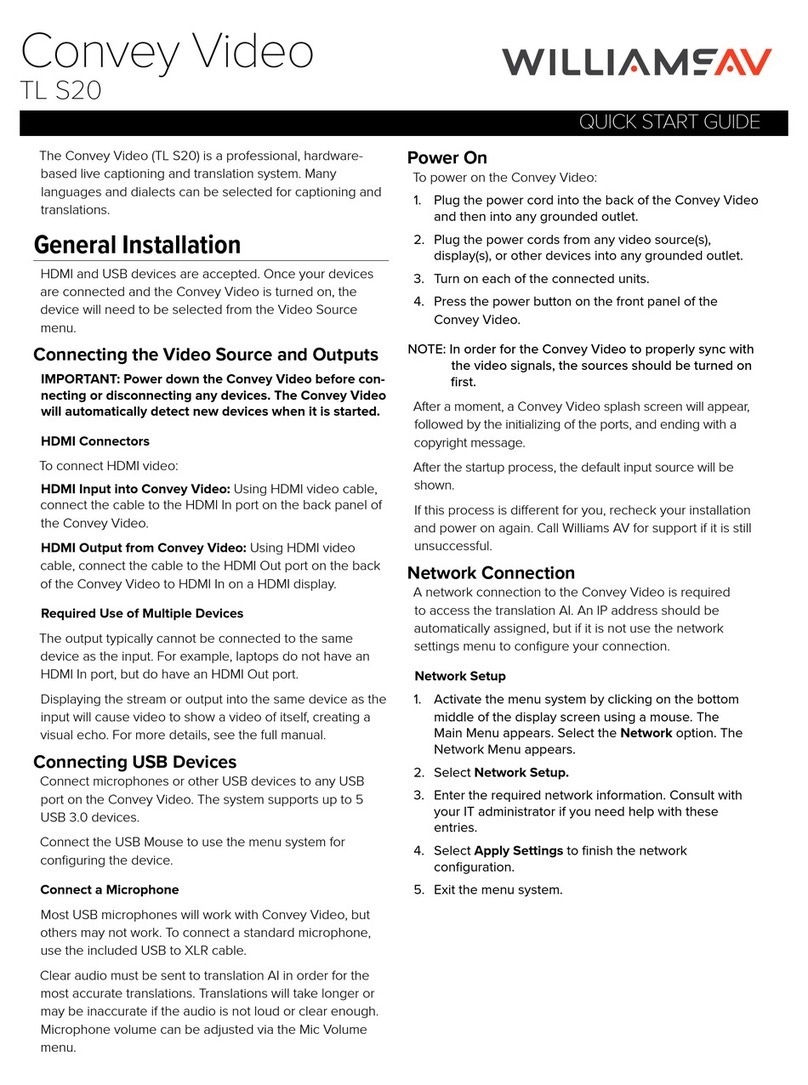
Williams AV
Williams AV Convey Video TL S20 quick start guide
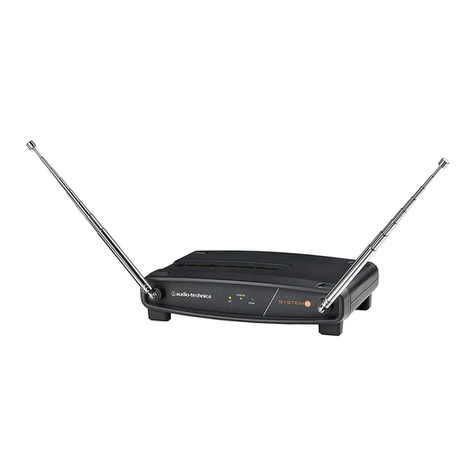
Audio Technica
Audio Technica System 8 Installation and operation
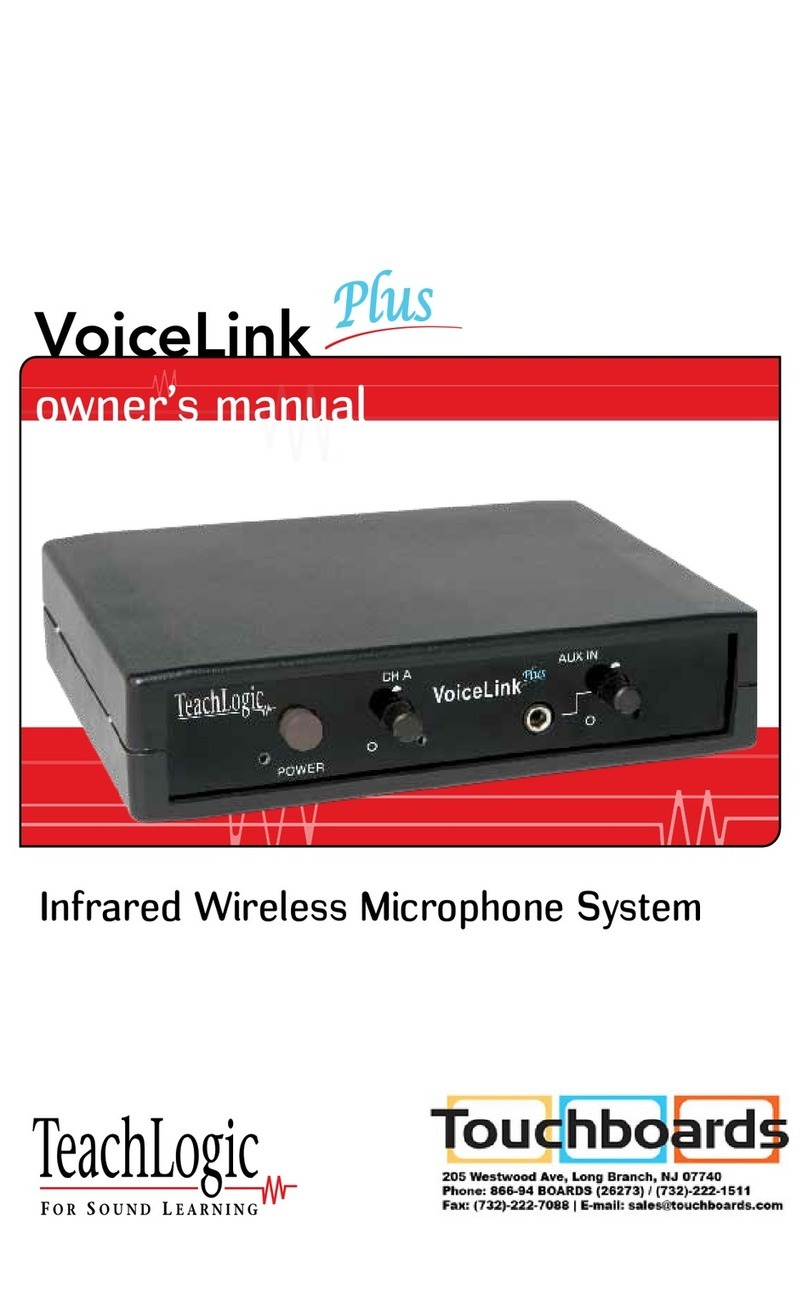
Touchboards
Touchboards TeachLogic VoiceLink Plus owner's manual
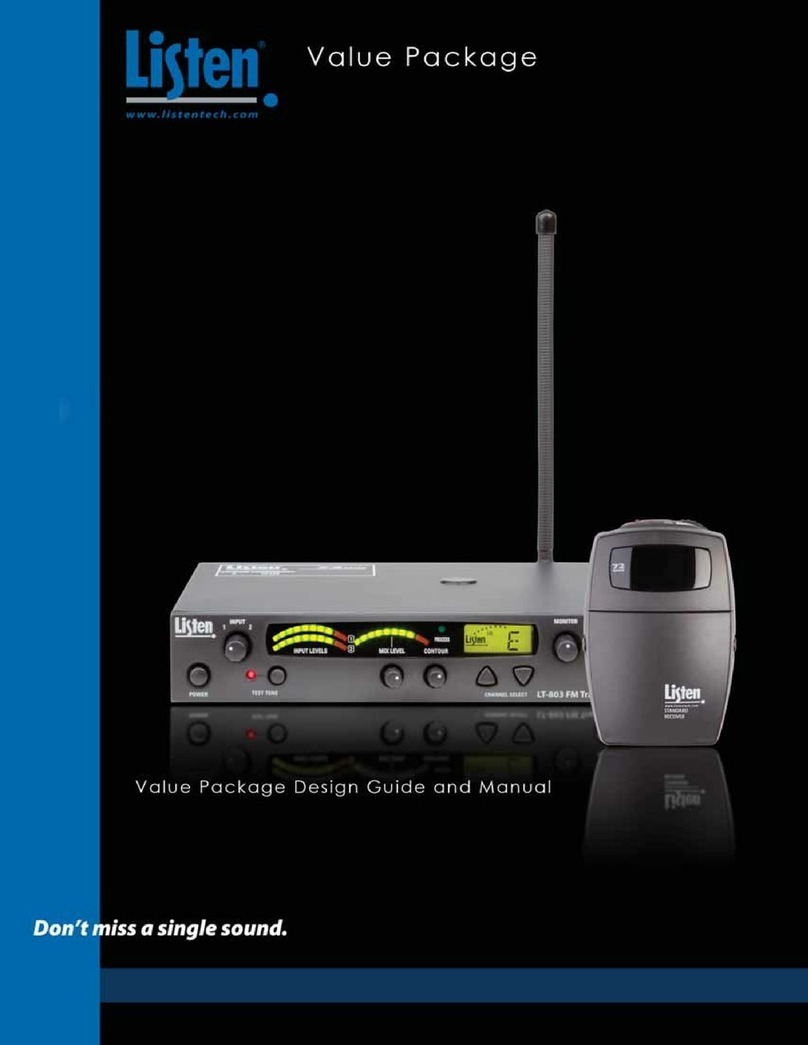
Listen Technologies
Listen Technologies LA-123 90 Design guide
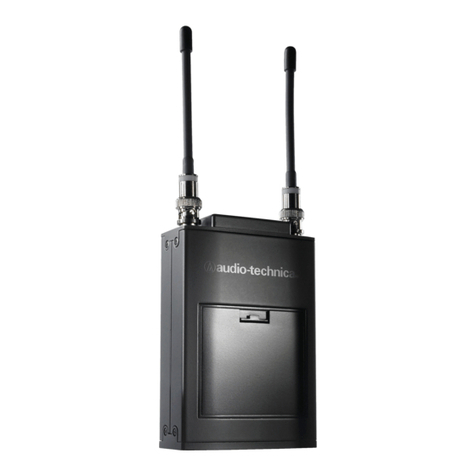
Audio Technica
Audio Technica 1800 Series Setup and operation manual

Shure
Shure EXHIBIT 212 manual
